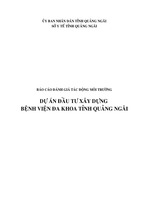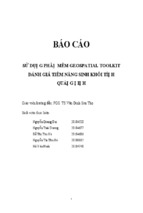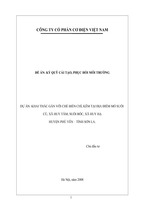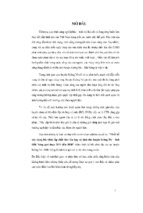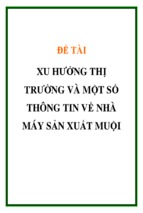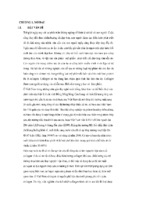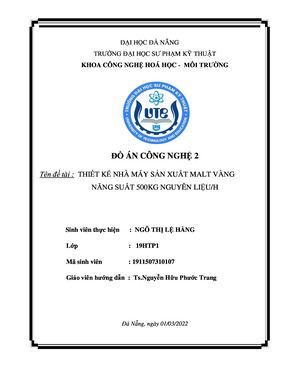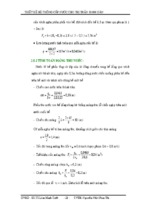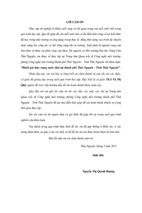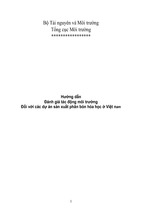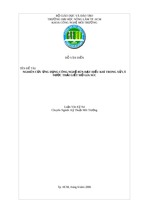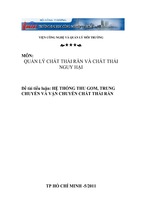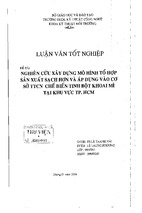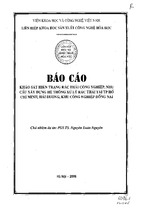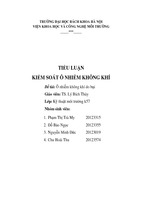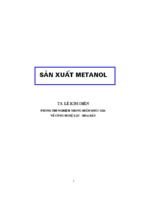1
INTRODUCTION
1. Rationale for this dessertation
Higher education is the highest learning and training level of a national
education system. In the trend of the globalization, international integration and
the development of knowledge-based economy today, higher education is
strongly affected by new approaches and faces up to the challenges. The renewal
of higher education is essential to ensure intellectual independence, to create and
advance knowledge, and to educate and train responsible, enlightened citizens
and qualified specialists, without whom no nation can progress economically,
socially, culturally or politically [70]. As the Declaration of the World
Conference on Higher Education Higher Education in the Twenty-first Century
Vision and Action (Paris, 5–9 October, 1998) emphasizes, since society is
“increasingly knowledge-based (...), higher education and research now act as
essential components of cultural, socio-economic and environmentally
sustainable development of individuals, communities and nations.” [70] The
development of higher education must therefore feature among the highest
national priorities.
An university president is a person at the forefront to lead or guide the
renewal and to implement the missions of his/her university. The university
president is a key person with an important responsibility for guiding the
academic and professional development, scientific research, technology transfer
and the overall activities of the university, also a person to make important
decisions affecting to the university’s development and survival, especially when
the mechanism of autonomy, self-responsibility and empowerment has been
recognized and appeared in reality, and when the renewal of higher education has
become a global trend.
The resolution on substantial and comprehensive renewal of higher
education of Vietnam in the period of 2006-2020 determines some achievements
of higher education, which have not been accomplished steadily, fundamentally
systematic, not met the requirements of industrialization and modernization of
the country, the learning needs of the people and international integration
requirements in the new periods. Latest, Resolution No. 29 of the Vietnam Party
Central Executive Committee dated 04/11/2013 on substantial and
comprehensive renewal of education and training determines the capacity
building of teachers and managers to meet the requirements for a renewal is a
task and a fundamental solution of the current education renewal [17].
Only in Hanoi, there are nearly 165 universities and colleges with 21.000
managers and lecturers (including 7.600 Masters, 2.700 PhDs and Doctors of
Science, over 1.200 Professors and Assistant Professors) conducting activities of
scientific research and training for nearly 500 thousands of students at all levels.
The capacity of university presidents, in fact, met basically the needs in term of
2
quantity but not adequately in structure, especially the growth of qualifications,
administration and managing competence is to meet the requirements of a
substantial and comprehensive renewal of higher education in a new context.
Annually, higher level management agencies and universities assess and
evaluate university presidents, but in a limited most common criteria reviewed
incomprehensively and in a limited scope. On the other hand, the capacity
buiding of university presidents has not really been recognized as a key strategy
with a long-term vision and systemmatical development solutions by the State
management agencies of higher education.
The innovation and development of higher education in the period of
industrialization and modernization of the country, the strong development of the
knowledge-based economy, the deeper and growing international integration, and
the increasing impacts of market mechanisms requires an in-depth study of the
capacity buiding of university presidents with a suggested theoretical and
practical issue system to recommend solutions to improve the university
president capacity buiding. Therefore, the authors have decided to study a thesis
titled “Capacity buiding of university presidents in Hanoi toward competencebased approach”.
2. Purpose of research
This research aims to suggest solutions to capacity buiding of university
presidents toward competence-based approach, which will contribute to an
increasingly quality improvement of university presidents in Hanoi in a context of
a substantial and comprehensive renewal of higher education of Vietnam today.
3. Subject and object of research
3.1. Subject of research: University president capacity buiding.
3.2. Object of research: Solutions to capacity buiding
presidents in Hanoi toward competence-based approach.
of university
4. Hypothesis of research
The research-based suggestion and application the solutions to capacity
buiding of university presidents toward competence-based approach on the basis of
competence framework with standards and criteria for professional position; and at
the same time, the implementation of capacity building solutions, such as
planning, training, selection and effective using will help improve the presidents’
management and leadership, and contribute to the universities’ development for a
renewal of the current higher education.
5. Tasks of research
5.1. Completing a theoretical research on capacity buiding of university
presidents toward competence-based approach.
3
5.2. Implementing a practical survey on the capacity of university
presidents and the university president capacity buiding in Hanoi toward
competence-based approach.
5.3. Recommending the solutions to capacity buiding of university
presidents in Hanoi toward competence-based approach. Also, conducting an
experimental research on predetermined solutions to evaluate their necessity and
feasibility.
6. Scope of research
6.1. Content
Focus on capacity buiding solutions of university presidents (or university
heads, who lead and manage the universites) toward competence-based approach.
6.2. Placement and participants of survey
- 3 groups of 14 universities in Hanoi: (1) Teacher Education and Training
Science (5214): 03 univ.; (2) Humanality (5222) and Social and Behavioral
Science (5231): 06 univ.; (3) Technical Technology (5251): 05 univ.
- Participants of survey: 331, including: Management Board (President and
Vice-President): 42; Office Head/Vice-Head: 48; Faculty Dean/Vice-Dean: 32;
Section Head/Vice-Head: 22; Lecturers: 159; Staff: 28.
7. Research methodology and methods
7.1. Methodology
- Dialectical materialism and historical materialism; - Approach to
system; - Approach to competence/competency; - Approach to human resource
management.
7.2. Research methods
7.2.1. Theoretical research methods
7.2.1. Practical research methods
- Survey (using questionnaires); - In-depth interviews; - Experience
summation; - Experts; - Testing; - Test.
7.3. Supporting methods
Using mathematical statistics, SPSS software to enter and process data.
8. Defensive issues
- Personnel is the origin of all the work. A university president plays a key
leadership role to build and develop a vision, missions, values and strategic
actions of the university to realize the missions of the school in the education and
training system, to meet the requirements of socio-economic, science and
technology development of the country and localities. University president
capacity buiding is considered a foremost key task in the leadership and
management of human resource development for higher education.
4
- The capacity building of president universities with a participation of
management and leadership stakeholders of the Party and the management bodies
of the State of higher education at all levels (MOET, managing ministries,
municipal/provincial People Committees, ...). In a coordinating management and
leadership mechanism of this development, each stakeholder has its role and
impact in line with the responsibility undertaken. Finding solutions in common
and specific adequate solutions haves an important contribution to build
presidents with qualities, qualifications and cabilities to lead the university
development in the context of fundamental and comprehensive renew of higher
education.
- Strengthening to lead an innovation of planning and effectively direct the
planning, building a competence framework for university presidents including
standards and criteria as a basis for recruitment, appointment based on a scientific
process, and also strengthening the training and retraining of capabilities,
qualities, and political fields are considered basic solutions to improve the quality
of university president capacity buiding of quality in this current period.
9. New findinds and contributions
Developing a system of concepts such as human resource development
competence, management and leadership, a dialectical relationship between
management and leadership, university management for the position of a
university presidents. A competence-based approach to human resource
development was chosen and determined to study the contents of the thesis.
The studies have not fully reviewed in general and particular about the
specific qualities and competencies of an university president, but a general
competence framework has also been mentioned in a number of studies.
Drawing a picture of current situation of capacity building of university
presidents in Hanoi, including its achievements, restrictions and causes.
On theoretical and practical research basis, the thesis suggested 06
solutions to capacity building of university presidents in Hanoi toward
competence-based approach, ensuring the feasibility and effectiveness.
10. Structure of the dissertation
This dissertation consists of these parts: introduction, three chapters,
conclusions and recommendations. The names of the three chapters include:
Chapter 1. Theoretical basis on capacity buiding of university presidents
toward competence-based approach
Chapter 2. Current situation of capacity buiding of university presidents in
Hanoi toward competence-based approach
Chapter 3. Solutions to university president capacity buiding in Hanoi toward
competence-based approach
5
Chapter 1.
THEORETICAL BASIS ON CAPACITY BUILDING OF UNIVERSITY
PRESIDENTS IN HANOI TOWARD COMPETENCE-BASED APPROACH
1.1. Literature Review
1.1.1. Research on capacity building of managers
In the middle of the eighteenth century, Western scientists as Robert Owen
(1771-1858), Charles Babbage (1792-1871), Andrew Ure (1778-1875) emerged
the idea of focusing on the elements of management to increase labor
productivity; Frederick Winslow Taylor (1856-1915) launched in 1911 four
scientific management principles: 1) specify the methods to complete each task;
2) recruitment and training of workers; 3) essential cooperation between
employers and employees; 4) duties of the employer to make plan and duties of
the employee to do plan; Henri Fayol (1841-1925) believed that an effective
management could be guaranteed if the manager has sufficient qualities and
capabilities combining the functions, rules and principles of management [3] [13]
[29]. Illina T.A, Savin N.V, and so on mentioned to the functions, positions and
roles of school administrators [40].
In 1970-1980s of the twentieth century, William Ouchi (California
University, Los Angeles, USA) confirmed the importance of culture in
management and outlined seven characteristics (7S) affecting to the effectiveness
of management. Leonard Nadle (1980) suggested three main tasks of human
resource management [excerpt from 13]. W.E.Deming, Crosby và Ohno (1991)
presented theories of Total Quality Management - TQM [excerpt from 13].
Schmuck et. al, (1997) discussed on Change Management Theory [28]. Harold
Koontz, Cyril Odonnel, and Heinz Eeihrich mentioned more on the quality
requirements of the manager in the book titled Essentials of management [29].
Bikas C.Sanyal, Micheala Martin, and Susan D’Antoni highlighted three basic
themes: 1) financial management; 2) management of teaching staff; 3)
management of used areas [3].
In Vietnam, Nguyen Minh Hac, Mai Huu Khue (1982) [43], Kieu Nam
(1983) [53], Pham Duc Thanh (1995) [64], Nguyen Minh Dao (1997) [18], Do
Hoang Toan (1998) [66], Nguyen Van Binh (1999) [4], Nguyen Phu Trong, Tran
Xuan Sam (2001) [excerpt from 68], Pham Thanh Nghi, Vu Hoang Ngan [13]
[40] [54] and so on mentioned the following issues:
1) A manager’s position and role at work, in an organization/unit have a
decisive significance for the work efficiency.
2) Staff and manager planning issues such as goals, attitudes, principles
and motto of the staff planning, the content and methodology of the staff
planning staff aim to build a capacity of managers meeting the requirements and
tasks of the country in new era.
6
3) Model of personality for the managers and training issues of human
capacity building in general, and managers in particular follows the standards of
personnel in the new era to meet the requirements of industrialization and
modernization of the country.
1.1.2. Research on capacity building of educational managers
Fred C. Lunenburg, Allan C. Orstein (2001), Matin Hilb (2003), K.B
Everard, Geoffrey Morris và Ian Wilson (2009) [3][13] mentioned essential
issues of capacity buiding of managers as follows:
1) Managers in general, educational managers in particular is approached
to human resource development, total human resource development and total
human resource management in an organization/unit.
2) This team can play a decisive role in the development of an
organization/unit, in a mutual relation to other contents of management inside
and outside of an organization/unit.
3) The competence of a manager as the most important factor of a quality
manager has been interested to research. On that basis, the contents of training
(diploma), retraining (certification) are developed and implemented in countries
around the world.
4) Educational managers as both managers and leader, the rapid adaptation
of individual managers and manager team in the drastic changes of the external
environment is the indispensable requirements.
In Vietnam, Nguyen Thi Doan, Do Minh Cuong, Phuong Ky Son [excerpt
from 13], Dang Quoc Bao, Dang Ba Lam, Tran Kiem, Bui Minh Hien, Vu Ngoc
Hai, Nguyen Loc, Phan Van Kha, Nguyen Tien Hung, Nguyen Ngoc Quang,
Nguyen Vu Bich Hien, Phan Van Nhan, Le Phuoc Minh,... [31] [40] [46] [50]
discussed this issues:
1) Basic views about theories on educational management and educational
managers: Educational managers and school management is the fulcrum, the
power source to ensure the consistency between educational management, school
management and teaching activities of the lecturers with an ultimate goal to
ensure the quality of training and fostering for education managers.
2) Referring to the role of educational managers, while proposing a variety
of solutions for the building and development of educational managers.
3) Concepts of educational managers and the implementation of basic
management functions of the educational managers. Besides, educational
managers should have specific abilities and skills. A training program should be
oriented to form and develop these abilities and skills for educational managers.
1.1.3. Research on capacity building of university presidents and university
presidents
7
Maheswari Kandasamy and Lia Blaton, Nguyen Minh Duong, Vu Ngoc
Hai, Phan Van Kha, Nguyen Cong Giap, Phan Tung Mau, Pham Quang Sang,
Nguyen Tien Dat, Do Minh Cuong, Nguyen Thi Doan, Nguyen Van De, Trinh
Ngoc Thach, Nguyen Thi Tuyet,... [3] [12] [31] [40]:
1) The issue of the national education system, planning, planning of the
development of education, educational development policies and policies for
teachers and educational managers.
2) Human resource development with specific issues such as management
model of training high-quality human resource in Vietnam universities; female
cadres in the management of universities; training and retraining of managers for
the schools, including the universities.
3) Orientations to develop university presidents and managers or leaders
with a university governance system which is steady and adequate with the
recruitment standards to appoint university presidents.
4) Launched models of qualities and capabilities for university presidents
as both managers and leaders, workers of educational management profession,
while distinguishing the superior/prominent points between management and
leadership of the president in the task duty.
1.1.4. Comments
1.1.4.1. Issues have not been addressed in the literature
1) President, as both managers and leaders - two factors in a person as the
head of the university.
2) A framework on specific standards and criteria for university presidents
should reviewed thoroughly and comprehensively.
3) Capacity building of university presidents is placed in a relationship
between direct management owners and undertaken task duty.
1.1.4.2. Issues should been studied and solved
(i) To solve the research purpose:
Research to propose solutions to capacity buiding of university presidents
toward standardization of qualifications, qualities and competencies based on a
competence framework with specific standards and criteria to improve
increasingly the capacity of university presidents.
(ii) To solve the research contents:
Competences and solutions to develop a competence framework with
specific standards and criteria based on job descriptions of university presidents.
(iii) To solve the basic research issues:
8
- Capacity buiding of university president is considered a foremost key
task in the leadership and management of human resource development for
higher education.
- General and specific solutions are adequate and fundamental to improve
increasingly the quality capacity buiding of university presidents in current
periods.
1.2. Key concepts
1.2.1. Manager, educational manager
1.2.1.1. Manager
A manager is a person who holds a position title in an organization after
being issued on an appointment decision to have a role of leadership and
implementation of management functions to achieve the objectives of the agency,
unit and organization.
1.2.1.2. Educational manager
An educational manager is a manager working at an educational
environment such as a school or educational management facility by performing
the basic roles and functions of management as well as specific management
issues in an educational organization to achieve its objectives.
1.2.2. University president
A university president is regarded as the head of a university with the
powers and responsibilities specified in the charter of the university.
1.2.3. University management
1.2.3.1. Management
The concept of management used in the study with a broad meaning,
including the following activities: leadership (developing a vision, leading to the
goal, affecting, promoting, etc.) and management (operating basic functions of
management).
1.2.3.2. Leadership
Leadership is leading the ways, show the directions; Leadership is a
process of orientation and determination of ways, objectives, leading the
organization to achieve the goals; Leadership is motivating, promoting,
encouraging the individuals to complete the tasks; Leadership is the ability to
affecting and attracting others to follow their guidance.
1.2.3.3. Relationship between leadership and management
The concept of management used in the study with a broad meaning,
including the following activities: leadership (developing a vision, leading to the
goal, affecting, promoting, etc.) and management (operating basic functions of
management) [48].
9
University presidents as both managers and leaders – ‘two sides of a coin’
in a unity [34].
1.2.3.4. University management
University management, belongings to conceptual categories of school
management, is a purposeful, oriented and scheduled process in which the
subjects of management (led by the president) will affect to the objects of
management (lecturers , staff, students, stakeholders, etc.) and mobilize and use
the resources with proper purposes and effectiveness to fulfill the mission of the
school to the education and training system, to the community and society in
order to achieve the predetermined objectives of education in a consistantly
changing environment [34].
1.2.3.5. University leadership
University leadership is a setting the goals, an orienting the strategic
development of university, an affection of the subjects of management (led by the
president) to lecturers, students, staff and all stakeholders to exert their
influence, win their voluntary trust and support, lead them to follow the school
leaders to realize the mission of the school to the education and training system,
to the community and society in order to meet the objectives of education and
training according to the needs of human society [34].
1.3. Contents and characteristics of the university presidents’ activities
1.3.1. Contents of the university presidents’ activities
1.3.1.1. Develop and organize the school structure [55]
1.3.1.2. Organize the implementation of the resolutions and decisions of the
school board
1.3.1.3. Develop a strategic plan for the school development, planning and
implementing the tasks in a school year
1.3.1.4. Manage the school human resource development
1.3.1.5. Manage the activities of training and scientific research
1.3.1.6. Manage the school finance and assets
1.3.1.7. Create working mechanisms and environment, implement staff policies
Activities of a university president is a complex system of mutual
supportive relationships to effectively implement the mission of a university. The
activity contents are a basis to identify job position requirements and the
qualifications and competence of a university president.
1.3.2. Characteristics of the university presidents’ activities
1.3.2.1. Activities of university presidents serve both leadership and
management functions
10
1.3.2.2. Concurrently perform tasks and functions of the upper-level
management agencies and the manager of a university
1.3.2.3. Activities of university presidents serve a multi-dimention model of
qualities and competencies
1.3.2.4. Activities of university presidents are performed in view of the role
of interaction, communication, decision-making
1.4. Capacity building of university presidents toward competence-based
approach
1.4.1. Theory on human resource development
1.4.1.1. Human resource
Is a complexibility of human resources (such as presidents, lecturers,
managers, administrative or serving staff, etc.) with the characteristics of
professional activities in the higher education facilities in order to meet the
requirements of the labor market.
1.4.1.2. Human resource quality
Quality is not only the attributes of a product or service but also the
extents of the attributes that meets the needs of consumers and service users in
specific conditions.
1.4.1.3. Human resource development
Capacity building of university presidents is a synchronized implementation
of impact by the subjects of management to build a capacity of presidents with a
sufficient quantity and assurance of qualifications, competences and moral
qualities to serve as the head position of a university.
1.4.2. Competence-based approach to human resource in university
president capacity buiding
Being a president is a profession, a president’s competency is required to
ensure the ability to solve practical problems in a creative way, to help the
university leadership and management achieve the best performance.
1.4.3. Competence framework for university presidents
Based on the analized results, a competence framework for university
presidents was developed in these following areas: (i) Political quality, morality,
lifestyle; (ii) Professional capabilities, pedagogical and scientific research
competence; (iii) Management and leadership competence; (iv) Social and
public relations competence; (v) International cooperation development and
integration competence; (vi) Career and personal development competence.
1.5. Contents of capacity building of university presidents toward
competence-based approach
1.5.1. Planning of capacity building of university presidents
11
1.5.2. Appointment and dismissal of university presidents
1.5.3. Training and retraining of university presidents
1.5.4. Remuneration policies for university presidents
1.5.5. Assessment of university presidents
1.6. Factors affecting to capacity building of university presidents
1.6.1. The objective factors (external)
1.6.1.1. Development of science and technology
1.6.1.2. Management mechanisms and policies of the State and the sector
1.6.2. The subjective factors (internal)
1.6.2.1. Educational environment or school culture
1.6.2.2. Qualities, capacities and qualifications of presidents
Conclusions of chapter 1.
Theoretical research results of chapter 1 are summarized as follows:
1. An overview on personnel development or capacity building of
educational management staff, managers and university presidents was a base to
highlight the existed problems and suggest for a study on solutions to capacity
building of university president toward competence-based approach to contribute
a higher quality improvement of president universities in Hanoi.
2. Key concepts, operational contents and characteristics of president
universities were discussed.
3. Other definitions such as human resource, human capacity building, and
human resource development stressed that a president is required to ensure the
ability to solve practical problems in a creative way, to help the university
leadership and management achieve the best performance, which helped us
choose the capacity building of university presidents toward competence-based
approach.
4. The studies have not fully reviewed in general and particular about the
specific qualities and competencies of an university president, but a general
competence framework has also been mentioned in a number of studies.
5. The capacity building of university presidents follows the steps of
human resource development such as planning, training - retraining, appointment
- dismissal, performance appraisal and assessment.
6. The capacity building of university presidents is affected by specific
objective and subjective factors that should be taken into account fully and
comprehensively
12
Chapter 2.
CURRENT SITUATION OF CAPACITY BUILDING OF UNIVERSITY
PRESIDENTS IN HANOI TOWARD COMPETENCE-BASED APPROACH
2.1. Overview on higher education in Vietnam and universities in Hanoi
2.1.1. Overview on higher education in Vietnam
2.1.1.1. Achievements, restrictions and shortcomings of higher education in
Vietnam
Achievements: (i) Higher education facilities are developed and widened
all over the country to meet better the learning needs of the society; (ii) Along
with the expansion of higher education, its quality and cultural quality also is
gradually improved; (iii) International cooperation in higher education is
increasingly expanded and strengthened.
Restrictions and shortcomings: (i) The system of higher education facilities
is still small, random, lack of concentration, irrational distribution among
localities and regions; (ii) Methods and mechanisms for the management of
universities and colleges throughout the country and in the city of Hanoi in
particular are inadequate, unsystematic, lack of the necessary stability; (iii)
Models of training and scientific research to ensure a link between the university
and an enterprise are limited.
2.1.1.2. Some orientations to develop higher education in Vietnam up to 2020
Including: 1) Changing the patterns of growth and development of higher
education; 2) Training based on the society’s needs, linking training with
employing, strengthening a cooperation between higher education facilities và
enterprises; 3) Re-adjusting some development indicators of higher education; 4)
Continuing to innovate the State management on higher education; 5) Deploying
stratification and ranking for higher education facilities; 6) Developing a national
qualification framework, standards on professional skills; 7) Innovating teaching
and learning, testing and assessment methods among which the innovation of
examination, testing and assessment is recognized a breakthrough in the
management of higher education; 8) Focus on improving the conditions for
quality assurance; 9) Establishing accreditation organizations; 10) Improving the
quality and efficiency of science and technology research; 11) Actively
integrating and improving the effectiveness of international cooperation in higher
education; 12) Actively implement a quality number of programs, schemes and
projects on higher education.
2.1.2. Overview on universities in Hanoi
Inspite of different groups of the universities, but most of universities in the
study area have a rich history and tradition of development, some of which have
more than 100 years, 50-60 years, or 20 years of development, etc. They have a
13
major contribution for human resource training for socio-economic sectors of the
country throughout historical periods.
In general, the universities have developed their mission statement, vision,
strategic planning of their development and invested all resources in
implementing their strategic plans, missions and vision. Their structure,
qualifications, training level, achievements in education, scientific research and
training of scientists has been constantly improved.
Statistics on presidents of 34 public universities in Hanoi is shown as
follows: Male: 33 (accounting for 97.06%); Female: 01 (accounting for 2.94%);
PhD: 5 (accounting for 14.71%); Ass.Prof.PhD: 22 (accounting for 64.71%);
Prof.PhD: 07 (accounting for 20.59%). In sum, 100% presidents are PhD and
most of them are Ass.Prof.PhD or upper, which meets the educational standard of
qualification for a president. However, only one president is female among 34
universities.
2.2. Overview on the survey
2.2.1. Purpose of the survey
The survey to evaluate the current status of university presidents by evaluate
the level of meeting the standards for university presidents toward competencebased approach and the current status of university presidents in Hanoi aimed to
have a practical basis to develop a competence framework with standards and
criteria in line with the job position and solutions to capacity building of
university presidents. Office Head/Vice-Head: 48; Faculty Dean/Vice-Dean: 32;
Section Head/Vice-Head
2.2.2. Placement and Participants
2.2.2.1. Survey placement: 4 universities of 03 groups.
2.2.2.2. Survey participants
Table 2.2. Numbers of survey participants
No.
Group
1.
Group
1
9
17
10
4
20
15
69
Group
2
18
14
11
12
65
21
126
Group
3
15
17
11
6
68
16
121
42
48
32
22
159
28
331
2.
3.
∑
Management Office
Faculty
Section
Lecturers Staff
Board
Head/Vice- Dean/Vice- Head/ViceHead
Dean
Head
Tổng
số
14
2.2.3. Contents, Tools and Evaluation Criteria
2.2.3.1. Survey contents and tools for the current status study of university
presidents in Hanoi
Including 06 standards and 41 criteria (Appendix 1).
The Interview Sheet on levels of meeting the standards for university
presidents consists of 09 questions (Appendix 2).
All the standard and criteria are rated among 3 levels: Good – Medium –
Not good.
2.2.3.2. Survey contents and tools for the current status study of capacity
building of university presidents in Hanoi
Including 05 standards and 36 criteria (Appendix 3).
The Interview Sheet on capacity building of university presidents consists of
07 questions for higher-level management agencies (Appendix 4).
All the standard and criteria are rated among 3 levels: Good – Medium –
Not good.
2.2.4. Methods
Instruction, In-depth Interview, Report Study.
2.2.5. Evaluation
Number, percentage (%), mean, ranking are scored for each standard,
criteria, survey content and tool (Form No. 1 and No. 3).
2.2.6. Data analysis methods
Mathematical statistics, using SPSS software or Microsoft Office Excel,
then an extract to analyze and draw conclusions.
2.3. Results of the current status on university presidents in Hanoi
In terms of: (i) Standard 1. Political quality, morality, lifestyle; (ii) Standard
2. Professional capabilities, pedagogical and scientific research competence; (iii)
Standard 3. Management and leadership competence; (iv) Standard 4. Social and
public relations competence; (v) Standard 5. International cooperation
development and integration competence; (vi) Standard 6. Career and personal
development competence.
Results: a) Political quality, morality, lifestyle of presidents was good; b)
Professional capabilities, pedagogical and scientific research competence was
prominient; c) Management and leadership was a remarkable competence of
university presidents; d) Implementing autonomy and social responsibility,
creating positive changes in schools was always concerned and performed; e)
Establishing a relationships with both upper management agencies and local
authorities were two criteria of social and public relations which is the president
focused on developing; g) Affirmed the vision and issues of integration between
15
the school and the regional and international trend of higher education
development, and professional, scientific prestige in the communities of the
region and globe.
Restrictions: (i) The ability to communicate the vision to the lecturers,
students and other stakeholders is limited; (ii) More focused on the
implementation of the management functions rather than leadership functions;
(iii) Not really remarkable achievements and reputation in scientific research
with the academic community; (iv) Respect, caring, understanding, behaving
justice with lecturers, staff and students; implementing the next generalization
planning, training and retraining; using and appointing talents and virtues and
promoting human capabilities; performing the role of senior managers; (v)
Establishing and developing relationships between the universities, cohering and
developing relationships with partners scopes the major challenges; (vi) Not
really interested in such issues as media, the implementation of social
accountability, roles of the community, school board, etc, has been not adequate
like solving a situation; (vii) Using foreign language in communication and
scientific exchange is limited.
There are internal and external causes lead to the restrictions above.
2.4. Results of the current situation of capacity building of university
presidents in Hanoi toward competence-based approach
In terms of: (i) Planning of capacity building of university presidents; (ii)
Appointment and dismissal of university presidents; (iii) Training and retraining
of university presidents; (iv) Remuneration policies for university presidents; (v)
Assessment of university presidents.
Picture of current situation of capacity building of university presidents in
Hanoi
Figure 2.5. Contents of capacity building of university presidents in Hanoi
16
- Results: (i) The contents of planning has focused on such issues as
influencing, guidance and assessment of upper-level leaders or management
agencies for the planning at the school level; (ii) University presidents have been
appointed and dismissed following the correct processes and procedures and no
president in his/her official term was dismissed during this study; (iii) The
drafting and promulgation of the macro-level documents of upper-level leaders or
management agencies is well-done, which ensure to create a legal framework for
university presidents to do leadership, management and operation of their
activities.
- Restrictions: (i) Strategic planning of the development and promulgation
of documents guiding the implementation has not really been focused, especially
lack of planning at the strategic level (more than 5 years); (ii) Lack of interest in
the development and promulgation of specific standards and contents for
university presidents; (iii) The renewal of appointment still based mostly on legal
documents, following usual procedures and routine; (iv) No training and
retraining programs with specific contents use for only university presidents; (v)
Recognition, motivation is an issue that needs to be taken into consideration by
upper-level leaders or management agencies to perform better.
Conclusions of chapter 2.
The study of the current situation of capacity building of university
presidents in Hanoi highlighted these results:
1) Sampling: 3 groups of 14 universities in Hanoi: (i) Group 1: Teacher
Education and Training Science (5214); (ii) Group 2: Humanality (5222) and
Social and Behavioral Science (5231); (iii) Group 3: Technical Technology
(5251) with participants of representatives from the Management Board,
Head/Vice-Head of Offices, Faculties, and Sections, lecturers and staff.
2) On the basis of analysis of the current status of university presidents and
capacity building of university presidents in Hanoi, we have a summary on
achieved results, restrictions and causes for each of two issue.
3) Along with theoretical study results in chapter 1 and practical research
results in chapter 2, we proposed a number of solutions to capacity building of
university presidents to meet the development demands of higher education in the
global integration periods.
17
Chapter 3.
SOLUTIONS TO UNIVERSITY PRESIDENT CAPACITY BUILDING IN
HANOI TOWARD COMPETENCE-BASED APPROACH
3.1. Orientation to suggest the solutions
3.2. Principles to suggest the solutions
3.2.1. Ensuring the goal
3.2.2. Ensuring the system
3.2.3. Ensuring the continuity and development
3.2.4. Ensuring the practicality and feasibility
3.3. Solutions to suggest
3.3.1. Research to develop the competence framework orientations for
university presidents
3.3.2. Renew the planning and guiding the effective implementation of
planning for university president capacity building
3.3.3. Renew the university president recruitment and appointment, and do
piloting and scaling the contesting forms for university presidents
3.3.4. Organize training, fostering and improving political and moral
qualities, and management and leadership competencies for university presidents
3.3.5. Implement standard-based assessment for university presidents
(i) Standard-based assessment for university presidents by leaders of upperlevel management agencies
(ii) Self-assessment for university presidents
(iii) Assessment for university presidents by lower-level university
managers, lecturers, staff
3.3.6. Make policies to honour the profession and motivations for selfdevelopment of university presidents
3.3.7. Relationship among solutions
The achievements of this work is the result of the synchronous and
comprehensive use of solutions above. Solution No. 1 is considered as a basis, a
prerequisite for an implementation of solutions No. 2, No. 3, No. 4 and No. 5,
and No. 6 is meant to promote both managers of a university president and the
university president. Solutions No. 2, No. 3 and No. 4 are considered as core
solutions to implement the university president capacity buiding. Solution No. 5
helps make adjustments, additions and decisions necessary for the university
president capacity buiding in general and for an individual president in particular,
18
and for leaders of direct management and leadership agencies for the university
presidents in particular.
3.4. Test the necessity and feasibility of the suggested solutions
3.4.1. Introduction of the experiment
a) Purpose
In order to obtain comments from the upper level management and
leadership agencies, personnel, lecturers, and staff of universities in the city of
Hanoi on the necessity and feasibility of solutions to capacity building of
university presidents.
b) Participants
Questionnaires were delivered to 03 groups of participants with a total
number of 346 persons, including: leaders of the upper level management and
leadership agencies (the Ministry of Education and Training, the managing
ministry, the Party committee of the universities and colleges in Hanoi): 15
persons; Presidents, managers, lecturers, staff: 331persons.
c) Content
06 suggested solutions to capacity building of university presidents in
Hanoi.
d) Method
Fill in the questionnaires for stakeholders to give opinions and combine
with direct discussion and interview if needed.
e) Evaluation
Scoring in the scale and ranking..
3.4.2. Results
Table 3.7. Ranking the necessity and feasibility
Necessity
No.
Solutions
Mean
of x
Feasibility
Rank of x
Mean
of y
Rank of y
1
Solution 1
2.94
1
2.85
1
2
Solution 2
2.60
3
2.42
3
3
Solution 3
2.54
4
2.36
5
4
Solution 4
2.43
5
2.33
6
5
Solution 5
2.82
2
2.38
4
6
Solution 6
2.41
6
2.54
2
Applying the Spearman’s formula on a correlation between the necessity
and feasibility of the measured solutions: r = 0.866.
19
This coefficient shows, this correlation is highly correlated. If applied
these solutions in practice of capacity building of university presidents, it brings a
high feasibility.
3.5. Experimental results for the suggested solutions to capacity building of
university presidents
3.5.1. Purpose of the experiment
Measuring the necessity and feasibility of implementing the suggested
solutions to capacity building of university presidents to have evidence for the
hypothesis.
3.5.2. Scope of the experiment
a) Content
Solution No.5 Implement standard-based assessment for university
presidents was chosen to do experiment.
b) Timetable
Based on actual training activities of the university and to ensure time for
research, testing of the solution was deployed within 6 months from 1/2015 to
6/2015.
c) Placement
Due to the conditions of time and the time of the suggested solutions, we
only tested in 03 universities, each of which was on behalf of 03 groups.
c) Participants
Total 108 persons:
- University presidents: 03 persons.
- Managers/Administrators: Vice-President; Office Head/Vice-Head;
Faculty Dean/Vice-Dean; Section Head/Vice-Head: 45 persons (15
persons/university).
- Lecturers: 90 persons (30 persons/university).
3.5.3. Tools, methods and procedures
a) Tools
First, the competence framework used in practical research on current
situation of university presidents with 6 standards and 41 criteria.
Second, assessment forms were developed and applied for 6 standards and
41 criteria of the competence framework used in practical research to test the
solution No.5, including:
(i) Self-assessment form for university presidents.
(ii) Assessment form of university presidents for personnels in their
workplaces.
20
(iii) Summary of assessment of university presidents for personnels in their
workplaces.
b) Methods and procedures
Along with all the contents in section 3.3.5. Implement standard-based
assessment for university presidents
c) Direction: Assessment and ranking for university presidents, assessment
team and process for university presidents.
Steps of the experiment:
(i) Have agreement with the President, Managers, lecturers, and staff about
the purpose of the experiment.
(ii) Instruct to use the assessment forms by giving points for each criteria
and standard following the Rating Instruction in the beginning of the forms.
(iii) Instruct to giving comments/remarks of the rater in the end of the
forms after finishing each section.
(iv) Collect evaluation forms, collecting data and comments/remarks of the
raters.
(v) Rating/Grading and evaluating as the head of direct higher level
management agency.
3.5.4. Scoring results
Total score of the competence framework for university presidents with 6
standards and 41 criteria is 410 points, scale of each criteria is 10.
Rating/Grading: a) Achievable (Excellent; Good; Medium); b) Not
Achievable (Bad).
Average score is below 5.0, equivalent to total score below 205 points or in
one of two cases: - have any criteria with 0 point or - hoặc - have any criteria in
Standard No. 2 and No.3 below 5 points.
3.5.5. Results
3.5.5.1. The university presidents’ self-assessment results
Figure 3.2 on Summary of meeting the standards and criteria among 03
presidents shows that the presidents pay more attention on self-development of
their qualities and cabilities to meet the job demands more effectively and
quality. The most positive change from before-experiment to after- experiment is
belongs to the President No.2 from 321.5 to 333.5 points (increasing12 points),
and then followed by the President No.3 from 327 to 337.5 points (increasing
10.5 points), and followed last by the President No.1 from 327 to 336.5 points
(increasing 8.5 points).
- Xem thêm -

